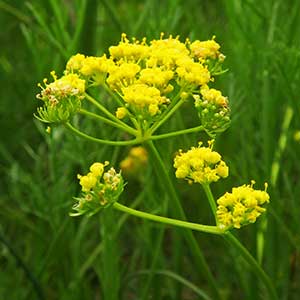Lomatium bradshawii
Bradshaw's biscuit-root, Bradshaw's desert-parsley, Bradshaw's lomatium
Leaves ternate-pinnately dissected into linear or filiform segments 3-10 mm. long and up to 1 mm. wide.
Inflorescence a compound umbel, the rays unequal, 4-13 mm. long; with usually only 2-5 fertile flowers;
involucre wanting;
bractlets of the involucel ternately or bi-ternately divided;
calyx teeth obsolete, flowers yellow.
Fruit glabrous, 8-13 mm. long and 5-7 mm. wide, the corky-thickened lateral wings half as wide as and the same color as the body.
Lomatium bradshawii
Occurring west of the Cascades crest in Clark County in Washington; southwestern Washington to the Willamette Valley near Eugene, Oregon.


